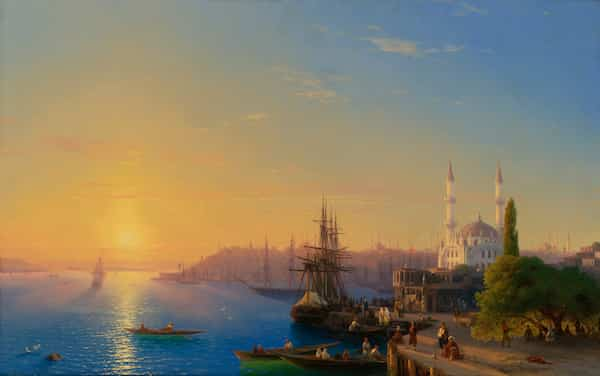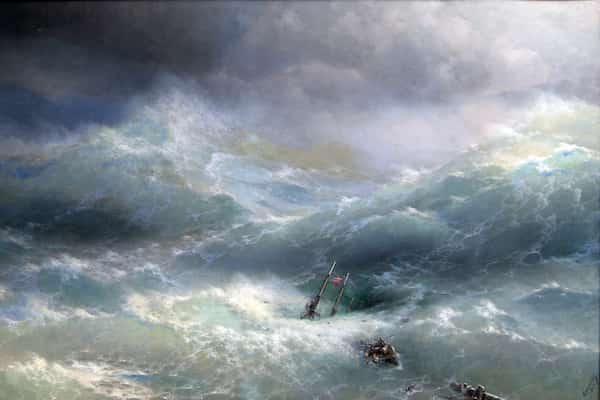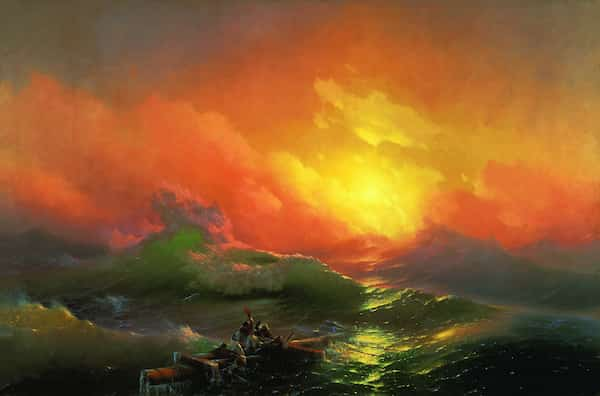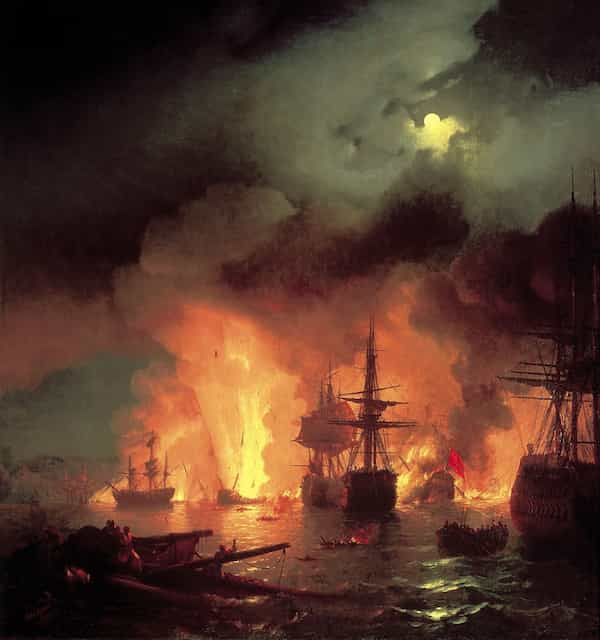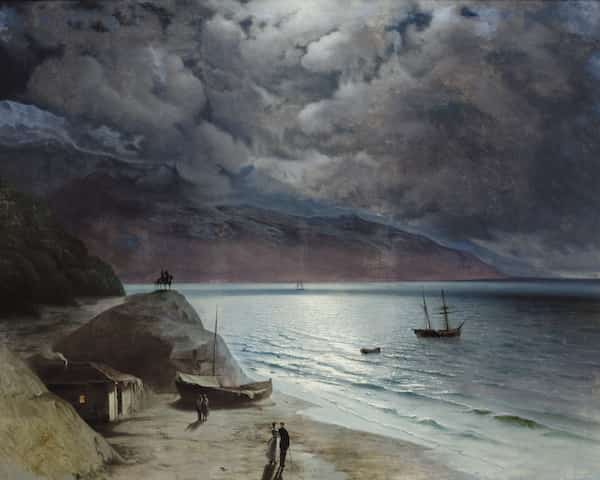Ivan Konstantinovich Aivazovsky (29 July 1817 – 2 May 1900) was an Armenian-Russian Romantic painter who is considered one of the greatest masters of marine art. He was born into an Armenian family in the Black Sea port of Feodosia in Crimea and was mostly based there. Following his education at the Imperial Academy of Arts in Saint Petersburg, Aivazovsky traveled to Europe and lived briefly in Italy in the early 1840s. He then returned to Russia and was appointed the main painter of the Russian Navy. Aivazovsky had close ties with the military and political elite of the Russian Empire and often attended military maneuvers. He was sponsored by the state and was well-regarded during his lifetime. The saying "worthy of Aivazovsky's brush", popularized by Anton Chekhov, was used in Russia for describing something lovely. He remains highly popular in Russia in the 21st century. One of the most prominent Russian artists of his time, Aivazovsky was also popular outside the Russian Empire. He held numerous solo exhibitions in Europe and the United States. During his almost 60-year career, he created around 6,000 paintings, making him one of the most prolific artists of his time. The vast majority of his works are seascapes, but he often depicted battle scenes, Armenian themes, and portraiture. Most of Aivazovsky's works are kept in Russian, Ukrainian, Armenian, Turkish museums as well as private collections.

Winter Landscape, Ivan Aivazovsky
Ivan Aivazovsky - Education
The young Aivazovsky received parochial education at Feodosia's St. Sargis Armenian Church. He was taught drawing by Jacob Koch, a local architect. Aivazovsky moved to Simferopol with Taurida Governor Alexander Kaznacheyev's family in 1830 and attended the city's Russian gymnasium. In 1833, Aivazovsky arrived in the Russian capital, Saint Petersburg, to study at the Imperial Academy of Arts in Maxim Vorobiev's landscape class. In 1835, he was awarded with a silver medal and appointed assistant to the French painter Philippe Tanneur [fr]. In September 1836, Aivazovsky met Russia's national poet Alexander Pushkin during the latter's visit to the Academy. In 1837, Aivazovsky joined the battle-painting class of Alexander Sauerweid and participated in Baltic Fleet exercises in the Gulf of Finland. In October 1837, he graduated from the Imperial Academy of Arts with a gold medal, two years earlier than intended. Aivazovsky returned to Feodosia in 1838 and spent two years in his native Crimea. In 1839, he took part in military exercises in the shores of Crimea, where he met Russian admirals Mikhail Lazarev, Pavel Nakhimov and Vladimir Kornilov.

Storm, Ivan Aivazovsky
Ivan Aivazovsky - Early European Travels
In 1840, Aivazovsky was sent by the Imperial Academy of Arts to study in Europe. He first traveled to Venice via Berlin and Vienna and visited San Lazzaro degli Armeni, where an important Armenian Catholic congregation was located and his brother Gabriel lived at the time. Aivazovsky studied Armenian manuscripts and became familiar with Armenian art. He met Russian novelist Nikolai Gogol in Venice. He then headed to Florence, Amalfi and Sorrento. In Florence, he met painter Alexander Ivanov. He remained in Naples and Rome between 1840 and 1842. Aivazovsky was heavily influenced by Italian art and their museums became the "second academy" for him. According to Rogachevsky the news of successful exhibitions in Italy reached Russia. Pope Gregory XVI awarded him with a golden medal. He then visited Switzerland, Germany, the Netherlands and Britain. In an international exhibition at the Louvre, he was the only representative from Russia. In France, he received a gold medal from the Académie royale de peinture et de sculpture. He then returned to Naples via Marseille and again visited Britain, Portugal, Spain, and Malta in 1843. Aivazovsky was admired throughout Europe. He returned to Russia via Paris and Amsterdam in 1844.
Sailing Ship by Moonlight, Ivan Aivazovsky
Ivan Aivazovsky - Return to Russia
Upon his return to Russia, Aivazovsky was made an academician of the Imperial Academy of Arts and was appointed the "official artist of the Russian Navy to paint seascapes, coastal scenes and naval battles." In 1845, Aivazovsky traveled to the Aegean Sea with Duke Konstantin Nikolayevich and visited the Ottoman capital, Constantinople, and the Greek islands of Patmos and Rhodes. In 1845, Aivazovsky settled in his hometown of Feodosia, where he built a house and studio. He isolated himself from the outside world, keeping a small circle of friends and relatives. Yet the solitude played a negative role in his art career. By the mid-nineteenth century, Russian art was moving from Romanticism towards a distinct Russian style of Realism, while Aivazovsky continued to paint Romantic seascapes and attracted heavy criticism. In 1845 and 1846, Aivazovsky attended the maneuvers of the Black Sea Fleet and the Baltic Fleet at Petergof, near the imperial palace. In 1847, he was given the title of professor of seascape painting by the Imperial Academy of Arts and elevated to the rank of nobility. In the same year, he was elected to the Royal Netherlands Academy of Arts and Sciences. In 1848, Aivazovsky married Julia Graves, an English governess. They had four daughters: Elena (1849), Maria (1851), Alexandra (1852) and Joanne (1858). They separated in 1860 and divorced in 1877 with permission from the Armenian Church, since Graves was a Lutheran.
Ivan Aivazovsky - Rise to Prominence
In 1851, traveling with the Russian emperor Nicholas I, Aivazovsky sailed to Sevastopol to participate in military maneuvers. His archaeological excavations near Feodosia lead to his election as a full member of the Russian Geographical Society in 1853. In that year, the Crimean War erupted between Russia and the Ottoman Empire, and he was evacuated to Kharkiv. While safe, he returned to the besieged fortress of Sevastopol to paint battle scenes. His work was exhibited in Sevastopol while it was under Ottoman siege. Between 1856 and 1857, Aivazovsky worked in Paris and became the first Russian (and the first non-French) artist to receive the Legion of Honour. In 1857, Aivazovsky visited Constantinople and was awarded the Order of the Medjidie. In the same year, he was elected an honorary member of the Moscow Art Society. He was awarded the Greek Order of the Redeemer in 1859 and the Russian Order of St. Vladimir in 1865. Aivazovsky opened an art studio in Feodosia in 1865 and was awarded a salary by the Imperial Academy of Arts the same year.
Ivan Aivazovsky - Travels and accolades: 1860s–1880s
In the 1860s, the artist produced several paintings inspired by Greek nationalism and the Italian unification. In 1868, he once again visited Constantinople and produced a series of works about the Greek resistance to the Turks, during the Great Cretan Revolution. In 1868, Aivazovsky traveled in the Caucasus and visited the Russian part of Armenia for the first time. He painted several mountainous landscapes and in 1869 held an exhibition in Tiflis. Later in the year, he made a trip to Egypt and took part in the opening ceremony of the Suez Canal. He became the "first artist to paint the Suez Canal, thus marking an epoch-making event in the history of Europe, Africa and Asia." In 1870, Aivazovsky was made an Actual Civil Councilor, the fourth highest civil rank in Russia. In 1871, he initiated the construction of the archaeological museum in Feodosia. In 1872, he traveled to Nice and Florence to exhibit his paintings. In 1874, the Accademia di Belle Arti di Firenze (Florence Academy of Fine Art) asked him for a self-portrait to be hung in the Uffizi Gallery. The same year, Aivazovsky was invited to Constantinople by Sultan Abdülaziz who subsequently bestowed upon him the Turkish Order of Osmanieh. In 1876, he was made a member of the Academy of Arts in Florence and became the second Russian artist (after Orest Kiprensky) to paint a self-portrait for the Palazzo Pitti. Aivazovsky was elected an honorary member of Stuttgart's Royal Academy of Fine Arts in 1878. He made a trip to the Netherlands and France, staying briefly in Frankfurt until 1879. He then visited Munich and traveled to Genoa and Venice "to collect material on the discovery of America by Christopher Columbus." In 1880, Aivazovsky opened an art gallery in his Feodosia house; it became the third museum in the Russian Empire, after the Hermitage Museum and the Tretyakov Gallery. Aivazovsky held an 1881 exhibition at London's Pall Mall, attended by English painter John Everett Millais and Edward VII, Prince of Wales.
Ivan Aivazovsky - Later Life
Aivazovsky's second wife, Anna Burnazian, was a young Armenian widow 40 years his junior. Aivazovsky said that by marrying her in 1882, he "became closer to [his] nation", referring to the Armenian people. In 1882, Aivazovsky visited Moscow and St Petersburg and then toured the countryside of Russia by traveling along the Volga River in 1884. In 1885, he was promoted to the rank of Privy Councilor. The next year, the 50th anniversary of his creative labors, was celebrated with an exhibition in St Petersburg, and an honorary membership in the Imperial Academy of Fine Arts. In 1887, as part of a jubilee celebration of his career, Aivazovsky hosted a dinner for 150 friends. Each guest received a miniature painting by Aivazovsky set into a studio photograph of the artist at work. After meeting Aivazovsky in person, Anton Chekhov wrote a letter to his wife on 22 July 1888 describing him as follows: Aivazovsky himself is a hale and hearty old man of about seventy-five, looking like an insignificant Armenian and a bishop; he is full of a sense of his own importance, has soft hands and shakes your hand like a general. He's not very bright, but he is a complex personality, worthy of a further study. In him alone there are combined a general, a bishop, an artist, an Armenian, an naive old peasant, and an Othello.
After traveling to Paris with his wife, in 1892 he made a trip to the United States, visiting Niagara Falls in New York and Washington D.C. In 1896, at 79, Aivazovsky was promoted to the rank of full privy councillor. Aivazovsky was deeply affected by the Hamidian massacres that took place in the Armenian-inhabited areas of the Ottoman Empire between 1894 and 1896. He painted a number of works on the subject such as The Expulsion of the Turkish Ship, and The Armenian Massacres at Trebizond (1895). He threw the medals given to him by the Ottoman Sultan into the sea and told the Turkish consul in Feodosia: "Tell your bloodthirsty master that I've thrown away all the medals given to me, here are their ribbons, send it to him and if he wants, he can throw them into the seas painted by me." He created several other paintings capturing the events, such as Lonely Ship and Night. Tragedy in the Sea of Marmara (1897)
He spent his final years in Feodosia. In the 1890s, thanks to his efforts a commercial port (ru) was established in Feodosia and linked to the railway network of the Russian Empire. The railway station, opened in 1892, is now called Ayvazovskaya [ru] and is one of the two stations within the city of Feodosia. Aivazovsky also supplied Feodosia with drinking water.
| Title | Date | Current Location |
|---|---|---|
| Jude's the Apostol betrayal | 1834 | Russian Museum (St. Petersberg) |
| View to the sea coast near St. Petersburg | 1835 | Tretyakov Gallery |
| Large raid in Kronstadt | 1836 | Russian Museum (St. Petersberg) |
| Windmill by the Sea | 1837 | Russian Museum (St. Petersberg) |
| Sea coast at night. Near the beacon | 1837 | Feodosia National Gallery |
| Look to the Large Cascade and Large Petergof Palace | 1837 | |
| Jalta | 1838 | Feodosia National Gallery |
| Frigate under sail | 1838 | Central Naval Museum |
| The Landing of N. N. Raevskyi at Subashi | 1839 | Samara Art Museum |
| End of Storm | 1839 | Tretyakov Gallery |
| Portrait of vice admiral M.P. Lazarev | 1839 | Central Naval Museum |
| Moon night on the Crimea | 1839 | Nikanor Onatsky Regional Art Museum |
| Old Feodosia | 1839 | Feodosia National Gallery |
| Sailing Ship on the Sea at Moonlight | 1839 | |
| Exchange Of Peterburg | 1840 | Cottage Palace |
| In the harbor. | 1840 | |
| Coast | 1840 | Tretyakov Gallery |
| Chaos. The Genesis | 1841 | San Lazzaro degli Armeni |
| The Bay of Naples | 1841 | Cottage Palace |
| Azure Grotto, Naples | 1841 | Donetsk Regional Museum of Art |
| Coast of Amalfi. | 1841 | Russian Museum (St. Petersberg) |
| Naples Bay | 1842 | |
| Neapolitan lighthouse | 1842 | |
| Moonlight in Naples | 1842 | |
| A bay near Venice | 1842 | Petergof |
| The Mekhitarist Fathers on Lazarus Island, Venice | 1843 | National Gallery of Armenia |
| Gondolier on the Sea at Night | 1843 | Tatarstan State Museum of Fine Arts |
| Shipwreck | 1843 | Feodosia National Gallery |
| Rescuers from the shipwreck | 1844 | National Gallery of Armenia |
| Survivors | 1844 | |
| Sveaborg | 1844 | Central Naval Museum |
| Stormy sea | 1844 | National Gallery of Armenia |
| Venetian lagoon. View of the island of San Giorgio | 1844 | Tretyakov Gallery |
| Venice | 1844 | Art Gallery of Tver |
| The bay of Naples | 1844 | Finnish National Gallery |
| Old Theodosia | 1845 | National Gallery of Armenia |
| Beach | 1845 | National Gallery of Armenia |
| Naples with a poet amongst fishermen | 1845 | |
| Reval (Tallinn) | 1845 | |
| Dusk on the Golden Horn | 1845 | |
| The Bay of Naples | 1845 | Cottage Palace |
| The Galata Tower by Moonlight | 1845 | |
| Sea view from the chapel on the shore | 1845 | Odesa Art Museum |
| The battle of Wyborg Bay | 1846 | |
| St. George Monastery. Cape Fiolent | 1846 | Feodosia National Gallery |
| Sea battle at Navarino | 1846 | Naval Engineering High School |
| The Russian Squadron on the Sebastopol Roads | 1846 | |
| Peter | 1846 | |
| Odessa at Moonlight | 1846 | Russian Museum (St. Petersberg) |
| View of Constantinople by evening light | 1846 | Cottage Palace |
| Boat Ride by Kumkapi in Constantinople | 1846 | Cottage Palace |
| Coffee-house by the Ortaköy Mosque in Constantinople | 1846 | Cottage palace |
| Golden Horn Bay Turkey | 1846 | Chuvashian State Arts Museum |
| View of Constantinople by moonlight. | 1846 | Russian Museum (St. Petersberg) |
| Entrée de port | 1846 | Musées Nationaux Récupération Department of Paintings of the Louvre |
| Ship, castle and sea | 1847 | National Gallery of Armenia |
| Chapel by the sea | 1847 | Art Gallery of Tver |
| Smolny Abbey. Sunset. | 1847 | |
| Мора | 1847 | Museum of Belarusian Polissia |
| Night in Venice | 1847 | Bashkir State Art Museum (Nesterov Museum) |
| La Tour de Léandre | 1848 | Tretyakov Gallery |
| Battle of Chesma | 1848 | Feodosia National Gallery |
| BrigMercury meets with the Russian squadron after the victory over two Turkish ships | 1848 | Russian Museum (St. Petersberg) |
| Battle of Chios | 1848 | Feodosia National Gallery |
| Sunset at the sea | 1848 | Latvian National Museum of Art |
| Mercury meets Russian squadrons after victory over two Turkish vessels | 1848 | Russian Museum (St. Petersberg) |
| The Canal Grande with a view of Santa Maria della Salute at sunset. | 1848 | |
| Stormy sea at night | 1849 | Pavlovsk Museum |
| Gurzuf at night | 1849 | National Pushkin Museum |
| Moonlight night | 1849 | Russian Museum (St. Petersberg) |
| Night at the Rodos island | 1850 | Belarusian National Arts Museum |
| Moonlit Night | 1850 | Ekaterinburg Museum of Fine Arts |
| Storm at sea | 1850 | National Gallery of Armenia |
| The storm at sea | 1850 | National Gallery of Armenia |
| Crimean Views | 1850 | Tatarstan State Museum of Fine Arts |
| Crimean Tartars on the Sea Shore | 1850 | |
| St. Petersburg - Galleon on the docks | 1850 | Sakıp Sabancı Museum |
| Ship on Stormy Seas | 1850 | |
| Along the Coast | 1850 | |
| The Bay of Yalta with the Magobi and Ai Petri mountains | 1850 | |
| Stormy Sea | 1850 | |
| The Ninth Wave | 1850 | Russian Museum (St. Petersberg) |
| Storm. | 1851 | Russian Museum (St. Petersberg) |
| Sunset at Sea | 1851 | Odesa Art Museum |
| View to the Crim | 1851 | Nizhny Novgorod State Art Museum |
| View of Moscow from the Sparrow Hills | 1851 | |
| Coast | 1851 | Russian Museum (St. Petersberg) |
| Theodosia. Moonlight night | 1852 | |
| Fishermen on the Beach | 1852 | National Gallery of Armenia |
| Feodosia. Moon night | 1852 | |
| The Harbor at Odessa on the Black Sea | 1852 | |
| Entrance to the Sevastopol Bay. | 1852 | Feodosia National Gallery |
| Moonlit night on the seashore in Crimea. | 1852 | Russian Museum (St. Petersberg) |
| Sebastopol | 1852 |

Stormy seas in the sunset, Ivan Aivazovsky
| Title | Date | Current Location |
|---|---|---|
| Battle of Sinope | 1853 | Central Naval Museum |
| The Battle of Sinope | 1853 | Central Naval Museum |
| Crimean coast by moonlight | 1853 | |
| Morning on the shore of the bay | 1853 | Feodosia National Gallery |
| Storm | 1853 | Russian Museum (St. Petersberg) |
| After the Storm | 1854 | Fine Arts Museum Kharkiv |
| Fishing Boats In A Harbor | 1854 | |
| Sinking Ship | 1854 | Russian Museum (St. Petersberg) |
| Theodosia Bay, sunrise | 1855 | National Gallery of Armenia |
| Sea View | 1855 | Art Gallery of Tver |
| View of Vico near Naples | 1855 | Art Gallery of Tver |
| Italian Landscape | 1855 | Art Gallery of Tver |
| Sheep driven by the storm into the sea. | 1855 | Tretyakov Gallery |
| View of Odessa on a moonlit night | 1855 | Kaluga Museum of Fine Arts |
| Strong Wind | 1856 | |
| View of Constantinople and the Bosphorus | 1856 | |
| Broad landscape with settlers | 1856 | |
| Winter Caravan on Road | 1857 | Smolensk Art Gallery |
| Sea on a Moonlit Night | 1857 | National Gallery of Armenia |
| Reeds on the Dnieper | 1857 | Feodosia National Gallery |
| Road in the Forest | 1857 | National Art Museum of Azerbaijan |
| Seascape with full moon | 1857 | Sakıp Sabancı Museum |
| The Island of Ischia at Sunset | 1857 | |
| Moonlit Night | 1858 | |
| Sea on a Moonlit Night | 1858 | National Gallery of Armenia |
| The Storm on the Turkish Coast | 1858 | |
| Italian Landscape (Lago Maggiore), Evening | 1858 | Feodosia National Gallery |
| Figures on a moonlit coast | 1858 | |
| Shipwreck of "Lefort" | 1858 | |
| Shepherds' Camp | 1858 | |
| Sailboat | 1859 | Odesa Art Museum |
| Moonlit night in the Crimea. | 1859 | Russian Museum (St. Petersberg) |
| Barge at Sea Shore | 1859 | Ekaterinburg Museum of Fine Arts |
| Wave hitting a Rock | 1860 | National Gallery of Armenia |
| Landscape with Windmills | 1860 | |
| Landscape in Crimea. | 1860 | National Museum in Warsaw |
| Storm | 1861 | |
| Sunset over Yalta. | 1861 | |
| The Island of Rhodes | 1861 | Feodosia National Gallery |
| Night in Constantinople | 1862 | National Gallery of Armenia |
| Chumaks Waggons | 1862 | Feodosia National Gallery |
| View in Crimea at sunset | 1862 | Russian Museum (St. Petersberg) |
| Moonlit Seascape With Shipwreck | 1863 | |
| Farm House and Windmill by moonlight | 1863 | |
| The Caucasus | 1863 | |
| Sea | 1864 | Ekaterinburg Museum of Fine Arts |
| Die See | 1864 | Feodosia National Gallery |
| Deluge | 1864 | |
| Moonlit coast | 1864 | |
| Odessa, view from the Sea | 1865 | National Gallery of Armenia |
| Theodosia, end of day | 1865 | National Gallery of Armenia |
| Crimean scene. Gurzuf at night | 1865 | National Gallery of Armenia |
| The Sea | 1865 | East Slovak Gallery |
| Ships at the raging sea | 1866 | Vyatskiy Art Museum |
| Little Russian Ox Cart in Winter | 1866 | |
| Sunset over the Golden Horn | 1866 | |
| Storm at Sea on a Moonlit Night | 1866 | Nizhniy Tagil State Museum of Fine Arts |
| A Summer’s Day in Crimea | 1867 | |
| In the roads, Evening | 1867 | Daghestan museum of fine arts |
| Daryal gorge | 1868 | National Gallery of Armenia |
| View Of The Ayu Dag Crimea | 1868 | |
| Winter Scene in Little Russia | 1868 | |
| From Mleta to Gudauri | 1868 | Daghestan museum of fine arts |
| Passing Ship on a Moonlit Night | 1868 | |
| Ship by Moonlight | 1868 | Metropolitan Museum of Art |
| Mountain Village Gunib in Daghestan. View from the East. | 1869 | |
| Suez Canal | 1869 | |
| Clashes between the Shirvans and the Murids on Gunib. | 1869 | |
| Petersburg. Crossing the Neva. | 1869 | Kiev National Picture Gallery |
| Der Fluss Rioni in Georgien | 1870 | National Gallery of Armenia |
| Ukrainian Landscape at Night | 1870 | |
| Icebergs in the Atlantic | 1870 | |
| The Tide | 1870 | Serpukhov historical-art museum |
| French Ships Departing the Black Sea | 1871 | |
| The Great Pyramid at Giza | 1871 | |
| Storm | 1871 | Muzeum Sztuki w Łodzi |
| Ships on Stormy Sea, Sunrise | 1871 | Russian Museum (St. Petersberg) |
| Storm | 1872 | National Gallery of Armenia |
| Ice on Dnipro | 1872 | |
| Storm | 1872 | |
| Shepherds with a flock of sheep. | 1872 | National Museum in Warsaw |
| Rainbow | 1873 | Tretyakov Gallery |
| American Shipping off the Rock of Gibraltar | 1873 | |
| Venice at Sunset | 1873 | |
| Storm at sea | 1873 | Rybinsk Museum-Preserve |
| Clouds Over a Calm Sea | 1873 | Donetsk Regional Museum of Art |
| The Shipwreck | 1873 | |
| Fishermen and their Families on the Shore of the Bay of Naples | 1873 | Museum of Fine Arts Boston |
| Self-portrait | 1874 | Uffizi Gallery |
| Gulf of Naples | 1874 | National Gallery of Armenia |
| Fishermen Returning Near Naples | 1874 | Dolmabahçe Palace |
| Frozen Bosphorus Under Snow | 1874 | Cankaya Mansion |
| Winter in Ukraine | 1874 | |
| Sea View | 1875 | National Gallery of Armenia |
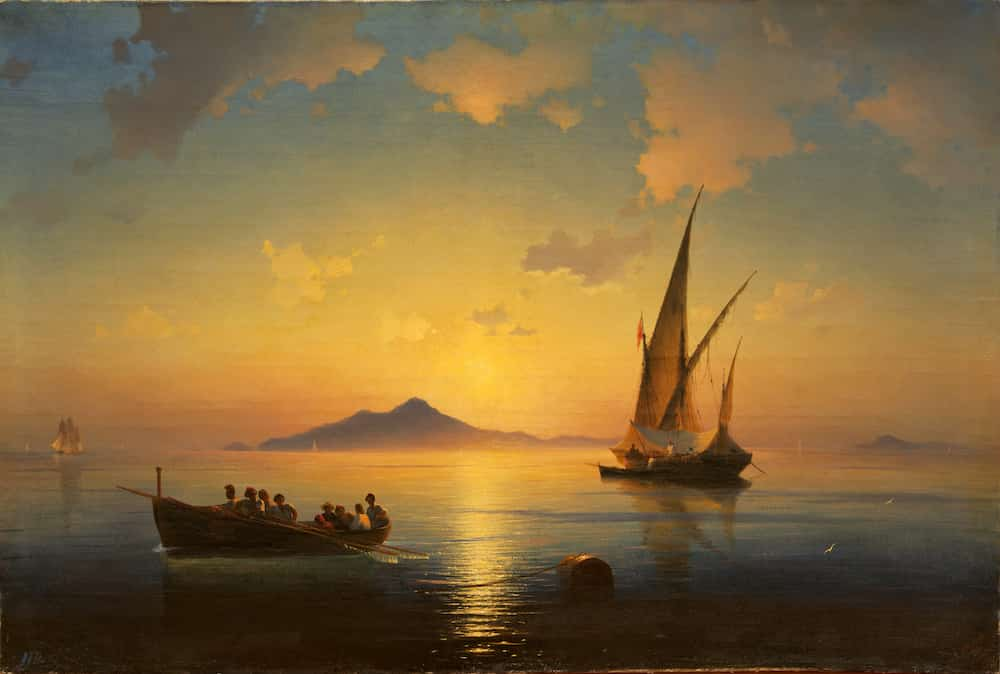
The Bay of Naples, Ivan Aivazovsky
| Title | Date | Current Location |
|---|---|---|
| A storm on rocky shores | 1875 | National Gallery of Armenia |
| Trebizond from the sea | 1875 | |
| shipwreck | 1876 | Feodosia National Gallery |
| Storm on the Sea | 1876 | National Gallery of Armenia |
| Winter landscape | 1876 | |
| Loading Provisions off the Crimean Coast | 1876 | |
| Solar Eclipse in Feodosia | 1876 | |
| Rocky Seashore | 1876 | Philadelphia Museum of Art |
| Moonlight at night near the spring | 1877 | National Gallery of Armenia |
| Mine attack by boats of the steamer Grand Duke Constantine | 1877 | Central Naval Museum |
| Sunset at sea | 1877 | Sakıp Sabancı Museum |
| Fight of the steamer Vesta with the Turkish battleship Fehti-Bulend in the Black Sea | 1877 | |
| Ice-Breakers on the Frozen Neva in St. Petersburg | 1877 | |
| Bosphorus | 1878 | |
| Alushta | 1878 | Feodosia National Gallery |
| Alexander II Crossing the Danube | 1878 | |
| Moonlit Night | 1878 | Golestan Palace |
| The Bay of Naples | 1878 | |
| The Black Sea at night | 1879 | Odesa Art Museum |
| Sunset | 1879 | Golestan Palace |
| Puskin in Crimea near Gurzuf rocks | 1880 | Odesa Art Museum |
| Storm | 1880 | Sakıp Sabancı Museum |
| The Survivor | 1880 | |
| The Burning of the Turkish Flagship by Kanaris | 1881 | National Gallery of Athens |
| Scenes from Cairo's life | 1881 | Kiev National Picture Gallery |
| Self Portrait | 1881 | Feodosia National Gallery |
| The Black Sea | 1881 | Tretyakov Gallery |
| Sarkizova Ann | 1882 | Feodosia National Gallery |
| Abandoning Ship | 1882 | |
| The Black Sea (Marina) | 1882 | National Gallery Prague |
| Morning on the sea | 1883 | |
| Dante Shows an Artist Some Unusual Clouds | 1883 | Feodosia National Gallery |
| Sunny Day | 1884 | |
| Constantinople, la mosquée de Top-Kahné | 1884 | Department of Paintings of the Louvre |
| A Rocky Coastal Landscape in the Aegean with Ships in the Distance | 1884 | |
| A View of the Bosporus with the Hagia Sophia and the Maiden's Tower in the Moonlight | 1884 | |
| Steamboat on a Moonlit Night | 1884 | |
| Calm early evening sea | 1884 | |
| Chumaks leisure | 1885 | Belarusian National Arts Museum |
| A Moonlit Night at Sea | 1885 | |
| Seascape | 1885 | Hermitage Museum |
| Parade of the Black Sea Fleet | 1886 | Central Naval Museum |
| The Wrath of the Seas | 1886 | |
| Storm | 1886 | |
| La Vague | 1886 | Department of Paintings of the Louvre |
| A. S. Pushkin and Countess M. N. Raevskaya by the sea near Gurzuf | 1886 | |
| Shipwreck on Stormy Seas | 1886 | |
| Sea coast | 1886 | Feodosia National Gallery |
| A. S. Pushkin at the Black Sea coast | 1887 | V. V. Vereshchagin Mykolaiv Art Museum |
| Pushkin's Farewell to the sea | 1887 | National Pushkin Museum |
| Calm Sea | 1887 | |
| Sailing Ships on a Calm Day. | 1887 | |
| Volga near the Zhiguli Mountains | 1887 | Kiev National Picture Gallery |
| Shipwreck off the Black Sea Coast | 1887 | |
| Ship Amid the Stormy Sea | 1887 | Hermitage Museum |
| Ox-carts in the Ukrainian steppe | 1888 | |
| Walking on Water | 1888 | Museum of history of religion |
| Descent of Noah from Ararat | 1889 | National Gallery of Armenia |
| The Wave | 1889 | Russian Museum (st Petersburg) |
| Destruction of Pompeii | 1889 | Rostov Regional Fine Arts Museum |
| Biarritz | 1889 | |
| Black Sea Fleet in the Bay of Theodosia | 1890 | Feodosia National Gallery |
| Passage of the Jews through the Red Sea | 1891 | |
| Rocky Cliffs | 1891 | Sakıp Sabancı Museum |



